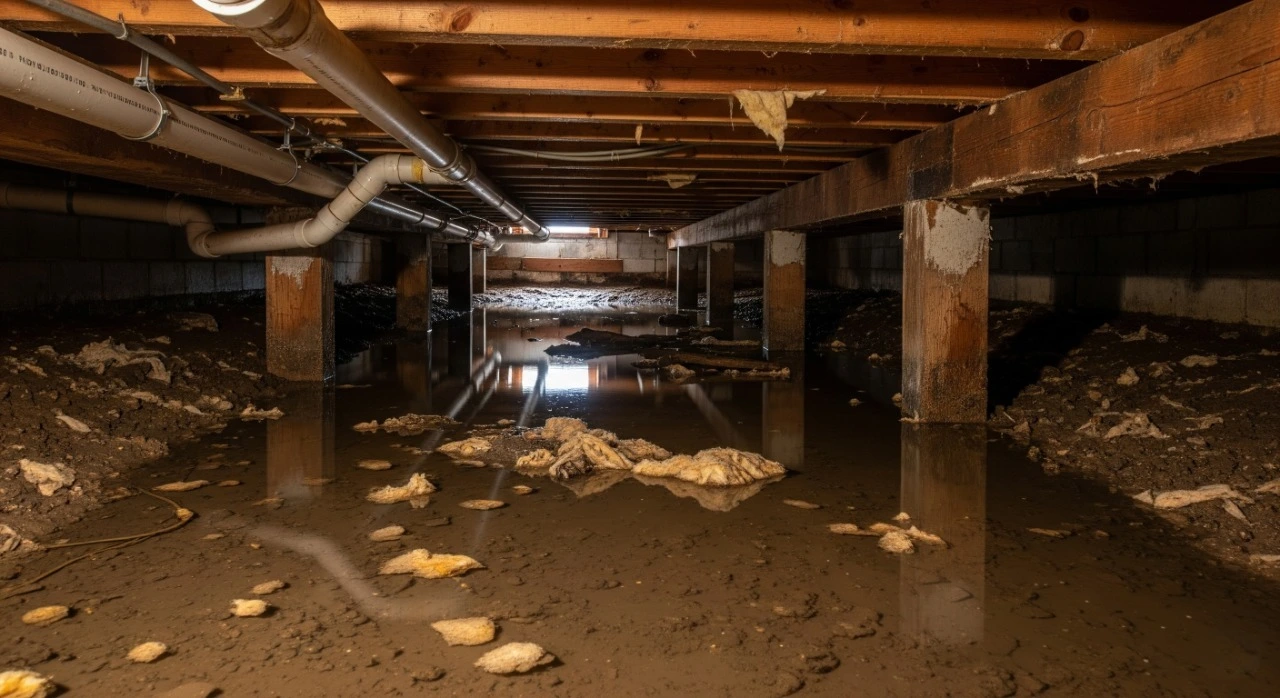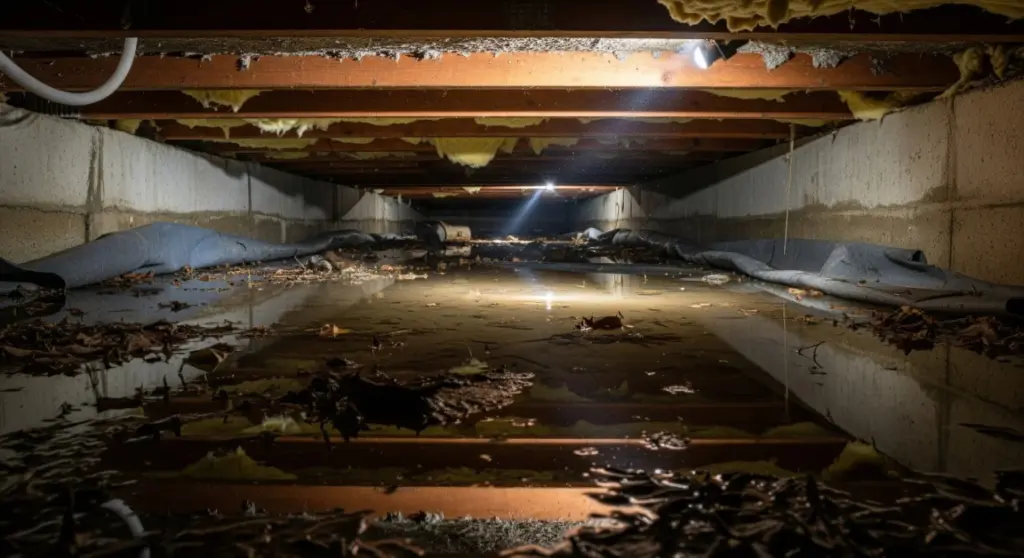
Introduction: The Sneaky Problem Beneath Your Feet
Beneath the floors in your home is an important but easy-to-ignore zone: the crawl space. Out of mind, however, it is the cause of the shape of your home and air cleanliness you breathe. When water appears beneath your crawl space, it is a sign of something far more sinister than a typical puddle.
You don’t know that up to 50% of the air on your ground floor is actually crawl space air. Because of what is referred to as the “stack effect,” where air will have a tendency to flow upward. If your crawl space is damp, that’s damp air, mold spores, and stinky odors migrating directly into your living area.
This guide will wrap up the main reasons for a damp crawl space, list the most essential threats, and introduce the final and most enduring solutions so that your house could be healthy, dry, and safe.
Top 4 Reasons for Water in a Crawl Space
The key to an enduring solution is to find out where the water is coming from. The problem usually has one or more of these four reasons:
- Surface Runoff Water: Rain and snow melt are the largest culprits. If your lawn is not graded so water will run away from your house, water will accumulate in front of your house. Downspouts that drop water onto the ground close to the foundation or gutters that are stopped up and overflow drop water onto the ground, and that water seeps in.
- Groundwater Seepage: When rain falls, the earth itself becomes wet and causes so-called “hydrostatic pressure.” That pressure exercises a great force on your foundation walls, pushing the water through small pores and cracks in the concrete. Houses in which the water table tends to be high are most vulnerable to such entry.3. Leaks in plumbing: A continuous, slow drip along a water pipe or drain pipe that travels through the crawl space will not be noticed for months. Continuous moisture is provided by this constant flow of water and saturation of insulation and can result in substantial structural damage over time.
- Leaks in plumbing: A continuous, slow drip along a water pipe or drain pipe that travels through the crawl space will not be noticed for months. Continuous moisture is provided by this constant flow of water and saturation of insulation and can result in substantial structural damage over time.
- Condensation and Humidity: Crawl space vents are not worthless in the majority of situations. Warm, damp air on humid summer days moves through vents into the crawl space and strikes cold surfaces like ductwork and pipes. It condenses—a house dew that drips on everything and adds to the humidity overall to lethal levels.
The Dangers of Ignoring Crawl Space Moisture
A damp crawl space is a breeding ground for problems that extend throughout your home and family. The consequences are simply too many to ignore:
- Structural damage: Continued water exposure damages your floor joists, supporting beams, and subfloor. It erodes the foundation of your home and causes sagging floors, sticking doors, and even foundation collapse.
- Mildew and Mold Growth: Mold loves dark, damp places. Black toxic mold and other fungus emit spores into the air that get vacuumed into your living area, causing allergies, asthma, and other toxic breathing issues. That pleasant odor in your house is a first warning sign.
- Pest Infestations: Wet areas are the perfect welcome mat for unwanted pests. Termites, carpenter ants, roaches, rodents, and dust mites thrive on water and rotten organic debris in a wet crawl space.
- Less Energy Efficiency: Humid air is more difficult to heat and cool. Wet insulation loses its R-value as well and is now useless. This causes your HVAC system to work much, much harder, which translates to much higher bills twelve months of the year.

Permanently Crawling Space Solutions to a Dry Crawl Space
To actually solve the problem, you need a system that’s fighting water and moisture from all angles. A professional solution most frequently includes three broad steps.
Step 1: Interior Drainage & Sump Pump System
The best solution to the battle against groundwater is to strike it when it does encroach. An interior drainage system is installed along the interior perimeter of the crawl space footing. The channel, specially designed, catches any water that does manage to enter and directs it to a low spot. There, the sump pump sits in an airtight pan. When the pan becomes a certain amount full, the pump starts up and directs the water out of your home in a controlled way.
Step 2: Crawl Space Encapsulation
Encapsulation is sealing your crawl space against damp ground and outdoor air. A thick, tear-proof vapor barrier is installed over the entire floor, up foundation walls, and around any support piers. Seams are sealed with simple waterproof tape, and crawl space vents are shut off permanently. The process keeps water vapor from coming up through the ground and keeps humid summer air out.
Step 3: A Crawl Space Dehumidifier
The last one is to control the air itself. After the space is sealed, a high-performance crawl space dehumidifier is installed in place. These high-capacity units will maintain the relative humidity automatically at or below 50%—the point at which mold will not develop. This maintains the air within the crawl space clean and dry, protecting the building and improving the air quality in your entire home.
Conclusion: A Smart Investment in Your Home’s Health and Value
Crawl space water treatment isn’t a Band-Aid, it’s the smartest investment you can make in your home.
A well-dry crawl space professionally water-proofed makes your house structurally solid, enhances your house comfort and worth, eliminates health hazards of mold, and saves you energy dollars. Don’t let any indication of dampness weaken. Let a professional waterproofing service company inspect your house from foundation to roof to make your house healthy and secure.
Frequently Asked Questions (FAQ)
Q: Do I leave my crawl space vents open or closed?
A: Vents should be closed up tightly now in an encapsulation system. Open vents, other than in extreme heat, allow wet air to enter in, and this leads to condensation and further for dampness problems.
Q: Am I required to hire a professional to fix my damp crawl space?
A: While small work such as downspout installation may be justified, full waterproofing with drainage and encapsulation must be performed with technical expertise, equipment, and materials to work for the long haul. Professional work guarantees a long-term solution.
Q: How costly is crawl space encapsulation?
A: It varies with condition and crawl space size. But it’s an investment that is well worth making. Encapsulation will cost considerably less to have done now than to repair extensive structural damage or address remediation in the future of mold in years to come.


